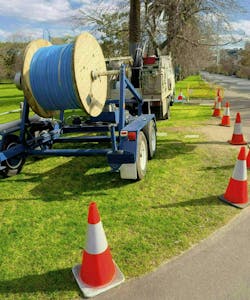Accelerated fiber deployments to drive uptick in broadband equipment spending
As Tier 1 and Tier 2 service providers ramp up their respective fiber builds, it is giving broadband access equipment vendors something to smile about: revenue growth.
A new Dell’Oro quarterly report revealed that the broadband access equipment market is projected to grow at an annual rate of 1.6% from 2024 to 2029, with total revenue peaking in 2028 due to ongoing DOCSIS 4.0 and fiber expansion by cable and fiber ISPs.
The research firm stated that PON equipment revenue is expected to grow from $10.7 billion in 2024 to $12.6 billion in 2029, mainly driven by XGS-PON deployments in North America, EMEA, and CALA, as well as FTTR (Fiber to the Room) and 50 Gbps deployments in China.
However, Dell’Oro noted that revenue for Cable Distributed Access Equipment (Virtual CCAP, Remote PHY Devices, Remote MACPHY Devices, and Remote OLTs) is expected to peak at $1.2 billion in 2028, as operators continue their DOCSIS 4.0 and early fiber deployments.
AT&T and Verizon raise fiber stakes
Dell’Oro raised its forecast from January due to what it says is an expected rise in fiber homes passed.
Two providers that are expected to drive potential growth for fiber broadband services are AT&T and Verizon.
AT&T has set a high standard for its network plan, with plans to invest in its network to reach an additional 4 million fiber customer locations annually by the end of 2026.
As a result of the policies outlined in the pro-investment elements of the Trump Administration’s One Big Beautiful Bill Act.
AT&T’s organic fiber builds will be bolstered by its pending acquisition of Lumen’s consumer fiber business and its Gigapower open access joint venture.
John Stankey, CEO of AT&T, said when the Lumen acquisition was announced that it “will allow us to accelerate fiber access to millions of new customer locations outside our traditional wireline operating region.”
Verizon is also charging fast with its fiber broadband expansion plans.
The service provider has set a goal to reach nearly an additional 700,000 Fios customers by the end of this year. This figure represents the fiber broadband customer base that will be gained upon completion of its acquisition of Frontier.
After it closes the Frontier acquisition, Verizon expects the combined build to be up to 1 million or more passings annually.
Tony Skiadis, CFO of Verizon, told investors during the company's second-quarter earnings call that it expects Frontier’s fiber network to reach more broadband customers and will provide an update on the deal soon. “We look forward to having Frontier's assets serve as an important catalyst for our fiber expansion and acceleration of broadband growth,” he said.
Broadband value focus shift
But for all the network expansion efforts, the key for fiber players won’t just be on providing high speeds.
Jeff Heynen, VP at Dell’Or Group, noted that the rise of AI applications and use cases will shift service providers’ focus to driving value, with an emphasis on three key metrics: throughput, latency, and jitter.
“We continue to see broadband providers balance ongoing expansion of their networks while also deploying platforms that will allow them to deliver service convergence and customized broadband applications, while also incorporating AI and automation tools,” Heynen said.
He added that “Though market presence in the form of homes passed remains today’s priority, future success will be all about delivering customized service tiers based on attributes beyond speed.”
FWA, Wi-Fi 7 transitions
Fixed Wireless Access and Wi-Fi 7 will continue to see transitions during Dell’Oro’s reporting period.
With a substantial influx of shipments of 5G sub-6 GHz and a growing number of 5G millimeter wave units, Fixed Wireless CPE revenue is expected to peak in 2025 and 2026.
Likewise, revenue for Wi-Fi 7 residential routers and broadband CPE with WLAN is expected to reach $8.6 billion by 2029, as both consumers and service providers rapidly adopt the technology.
For related articles, visit the Broadband Topic Center.
For more information on high-speed transmission systems and suppliers, visit the Lightwave Buyer’s Guide.
To stay abreast of fiber network deployments, subscribe to Lightwave’s Service Providers and Datacom/Data Center newsletters.
About the Author
Sean Buckley
Sean is responsible for establishing and executing the editorial strategy of Lightwave across its website, email newsletters, events, and other information products.




